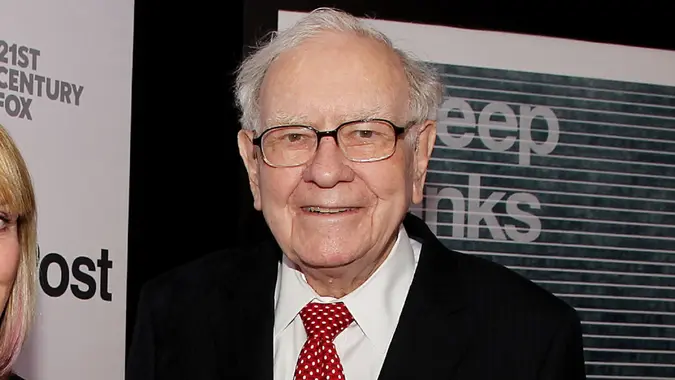What’s the Best Way To Invest Like Buffett — Berkshire or Berkshire’s Investments?

Commitment to Our Readers
GOBankingRates' editorial team is committed to bringing you unbiased reviews and information. We use data-driven methodologies to evaluate financial products and services - our reviews and ratings are not influenced by advertisers. You can read more about our editorial guidelines and our products and services review methodology.

20 Years
Helping You Live Richer

Reviewed
by Experts

Trusted by
Millions of Readers
Warren Buffett is one of the most successful investors of all time. As the chairman of Berkshire Hathaway, who will soon be stepping down, he has built a fortune by following a long-term investing strategy — buying businesses with economic moat at fair prices and holding them for years. His strategy has beaten the stock market for decades.
So, if you want to invest like Buffett, there are two ways to do it. You can buy Berkshire Hathaway stock and benefit from the company’s mix of businesses and investments. Or you can try to copy Berkshire’s portfolio by buying the same stocks the company holds.
Both options have their pros and cons. The best choice for you will depend on how involved you want to be in managing your investments and how much control you want over what you own.
Invest in Berkshire Hathaway Stock
When you buy shares of Berkshire Hathaway (BRK.A or BRK.B), you’re buying a piece of a huge, diversified business. Berkshire owns insurance companies, utilities, a railroad, an energy business, manufacturing companies, retail stores, and a large stock portfolio. Since 1965, this mix of businesses has delivered a compounded annual return of 20%.
Investing in Berkshire Hathaway stock means you don’t have to research or keep track of dozens of individual companies yourself. However, Berkshire shares, especially Class A (BRK.A), trade at a premium. Still, Class B shares (BRK.B) are worth adding to your portfolio.
Invest in Berkshire’s Holdings
Alternatively, you can mimic Berkshire’s equity portfolio by investing directly in the individual holdings disclosed in its quarterly 13F filings, like Apple, Coca-Cola, Bank of America, and American Express, among others. This will give you more control over how much you allocate to each stock.
Another way is to invest in exchange-traded funds (ETFs) that replicate Buffett’s investment strategy. For example, the Market Vectors Wide Moat ETF (NYSEARCA: MOAT) or the SPDR Financial Select Sector ETF (NYSEARCA: XLF). These ETFs provide diversified, low-cost exposure to companies fitting Buffett’s value and economic moat criteria.
However, replicating Berkshire’s portfolio requires ongoing effort, monitoring, rebalancing, and ensuring you stay within your ‘circle of competence,’ a Buffett principle that warns against investing in companies you don’t fully understand.
Should You Invest in Berkshire Stock or Berkshire’s Holdings?
The decision comes down to your goals, time commitment and comfort level with managing a portfolio.
If you invest in Berkshire Hathaway shares, you’re buying a professionally managed portfolio. You don’t need to track individual holdings or rebalance positions. Your job is to look for buying opportunities, and the best way to do it is dollar cost averaging.
If you choose to invest directly in Berkshire’s top holdings, you gain more control. You can decide how much to allocate to Apple, Coca-Cola, Bank of America, or any other company Berkshire holds. Going this route means more work. You’ll need to keep an eye on market conditions, company fundamentals and any changes to Berkshire’s portfolio.
Whether you choose to invest in Berkshire stock or Berkshire holdings, Buffett’s principles remain the same. Make sure you invest in businesses you understand, look for companies with economic moat, focus on fundamentals over trends, and be patient.
 Written by
Written by  Edited by
Edited by 

























